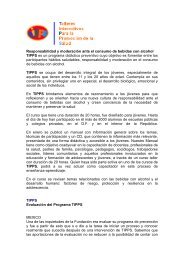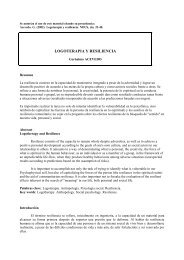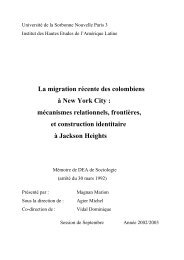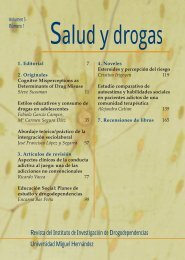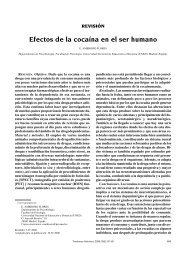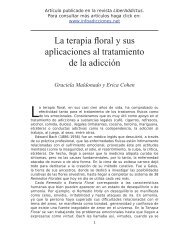migrant women in the United Arab Emirates
migrant women in the United Arab Emirates
migrant women in the United Arab Emirates
You also want an ePaper? Increase the reach of your titles
YUMPU automatically turns print PDFs into web optimized ePapers that Google loves.
Foreword<br />
Chang<strong>in</strong>g labour markets with globalization have <strong>in</strong>creased both opportunities and<br />
pressures for <strong>women</strong> to migrate. The migration process and employment <strong>in</strong> a country of which<br />
<strong>the</strong>y are not nationals can enhance <strong>women</strong>’s earn<strong>in</strong>g opportunities, autonomy and<br />
empowerment, and <strong>the</strong>reby change gender roles and responsibilities and contribute to gender<br />
equality. But <strong>the</strong>y also expose <strong>women</strong> to serious violation of <strong>the</strong>ir human rights. Whe<strong>the</strong>r <strong>in</strong> <strong>the</strong><br />
recruitment stage, <strong>the</strong> journey or liv<strong>in</strong>g and work<strong>in</strong>g <strong>in</strong> ano<strong>the</strong>r country, <strong>women</strong> <strong>migrant</strong><br />
workers, especially those <strong>in</strong> irregular situations, are vulnerable to harassment, <strong>in</strong>timidation or<br />
threats to <strong>the</strong>mselves and <strong>the</strong>ir families, economic and sexual exploitation, racial<br />
discrim<strong>in</strong>ation and xenophobia, poor work<strong>in</strong>g conditions, <strong>in</strong>creased health risks and o<strong>the</strong>r<br />
forms of abuse, <strong>in</strong>clud<strong>in</strong>g traffick<strong>in</strong>g <strong>in</strong>to forced labour, debt bondage, <strong>in</strong>voluntary servitude<br />
and situations of captivity. Women <strong>migrant</strong> workers, whe<strong>the</strong>r documented or undocumented,<br />
are much more vulnerable to discrim<strong>in</strong>ation, exploitation and abuse – relative not only to male<br />
<strong>migrant</strong>s but also to native-born <strong>women</strong>. Gender-based discrim<strong>in</strong>ation <strong>in</strong>tersects with<br />
discrim<strong>in</strong>ation based on o<strong>the</strong>r forms of “o<strong>the</strong>rness” – such as non-national status, race,<br />
ethnicity, religion, economic status – plac<strong>in</strong>g <strong>women</strong> <strong>migrant</strong>s <strong>in</strong> situations of double, triple or<br />
even fourfold discrim<strong>in</strong>ation, disadvantage or vulnerability to exploitation and abuse.<br />
To enhance <strong>the</strong> knowledge base and to develop practical tools for protect<strong>in</strong>g and<br />
promot<strong>in</strong>g <strong>the</strong> rights of female <strong>migrant</strong> workers, a series of case studies were commissioned.<br />
These studies were <strong>in</strong>tended to provide background materials for an Information Guide on<br />
Prevent<strong>in</strong>g Discrim<strong>in</strong>ation, Exploitation and Abuse of Women Migrant Workers. The Guide,<br />
which is comprised of six <strong>in</strong>dividual booklets, aims at assist<strong>in</strong>g and enhanc<strong>in</strong>g <strong>the</strong> efforts of<br />
government agencies, workers’ and employers’ organizations, non-governmental organizations<br />
and civil society groups <strong>in</strong> send<strong>in</strong>g, transit and dest<strong>in</strong>ation countries to protect <strong>the</strong> human rights<br />
of <strong>women</strong> <strong>migrant</strong> workers <strong>in</strong> <strong>the</strong> different stages of <strong>the</strong> migration process.<br />
This work<strong>in</strong>g paper is based on one of <strong>the</strong> country case studies. The countries covered<br />
<strong>in</strong>cluded Bolivia, Costa Rica, Italy, Japan, Nicaragua, Ethiopia, Nigeria, <strong>the</strong> Philipp<strong>in</strong>es, Sri<br />
Lanka and <strong>the</strong> <strong>United</strong> <strong>Arab</strong> <strong>Emirates</strong>. The focus was on <strong>the</strong> situation of <strong>the</strong> <strong>women</strong> <strong>migrant</strong><br />
workers <strong>in</strong> <strong>the</strong>ir families, workplaces, communities and societies <strong>in</strong> send<strong>in</strong>g and receiv<strong>in</strong>g<br />
countries and also on <strong>the</strong> <strong>in</strong>itiatives, policies and programmes, “good” and “bad” practices<br />
implemented by government, private recruitment and employment agencies and a wide range<br />
of social actors to assist and protect <strong>women</strong> <strong>migrant</strong>s aga<strong>in</strong>st exploitation and abuse and to<br />
prevent <strong>the</strong>m from be<strong>in</strong>g trafficked.<br />
The case studies represent a collaborative effort between <strong>the</strong> Gender Promotion<br />
Programme and <strong>the</strong> International Migration Branch, as well as a number of Area and Regional<br />
ILO Offices. Kater<strong>in</strong>e Landuyt had ma<strong>in</strong> responsibility for commission<strong>in</strong>g <strong>the</strong> case studies.<br />
Tanja Bastia provided technical guidance to <strong>the</strong> national consultants, while M<strong>in</strong>awa Ebisui and<br />
Ti<strong>in</strong>a Eskola provided editorial and formatt<strong>in</strong>g assistance.<br />
L<strong>in</strong> Lean Lim<br />
Manager<br />
Gender Promotion Programme<br />
iii



